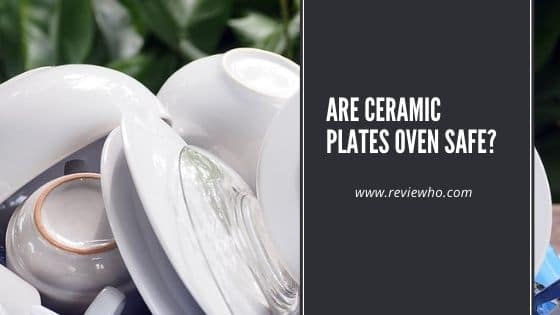You will find a wide range of dinnerware. There are differences in the materials used to create them, as well as the patterns they have. Most of the people who shop around for dinnerware want an option that is completely oven safe. Oven safe bowls and plates can be moved directly from the fridge, to the oven, and to the table, which eradicates the need for using multiple utensils, reducing the cleanup.
Ceramics are a very common type of dinnerware in the world today. Can you put ceramic plates in the oven? Well, this article aims to help shed a light on that question. Let’s get started.
About Ceramic Plates
Most plates are usually made using ceramic. There are wide varieties of materials classified under ceramic materials. There are bon china, porcelain, stoneware, glazed earthenware. There are plates made with materials such as plastics and other materials created in the modern era. However, ceramic plates remain the most common variety available in the market.
Why Ceramic Plates break in an oven
Are ceramic plates oven-safe? Well, the truth is that most people will assume that ceramic plates are automatically oven safe and can be used in the oven for any reason, which includes reheating food.
Believe it or not, not all ceramic plates can go in the oven. Ceramic plates are not created in the same manner. Some plates have to go through a firing process in which they are exposed to extremely high temperatures. Some do not go through that process.
Ceramic plates are made using earthen elements, clay, water, and a bit of powder. A combination of these materials is then shaped into a certain desired form. Once the shape is achieved, the plate will be fired in an oven at a very high temperature.
Unfortunately, the ceramic plate glaze will not automatically be oven safe. In case the glaze is not waterproof, the clay inside the plate will remain unprotected and subtle to changes in temperature.
Identifying Oven Safe Ceramic Plates
So, how do you know if a ceramic plate is oven-safe? We have established that some are and some are not. The following should help you identify the plates that are oven safe and the ones that are not.
Label
You might realize that most items, whether ceramic or not, will have a mark to state that they are ovenproof. Ceramic plates are no exception. If you purchase a ceramic plate, you should check at the bottom for a mark or stamp to state that the plate is ovenproof. For that reason, if you want to purchase an oven-safe ceramic plate, you should always check for that label before you take it out of the store.
Thickness
Before you use a ceramic plate in the oven, check the thickness. The thickness should help you identify the level of temperature changes that the plate can withstand without shattering to pieces. Sounds easy, right? Here is the explanation.
When you place a thick ceramic plate inside an oven, it will raise its temperature at a slow pace. When you remove it from the oven, it will lose the temperature at the same speed. A thin plate will act opposite. The thickness of the ceramic plate will help to protect the integrity of the plate and it will not break due to the temperature changes.
Caution
Before you use ceramic plates in the oven, you should consider certain precautions, as explained below.
You should make sure that the plate does not have any silver, gold, or metallic trim that is used to decorate the dish.
If you have a glazed ceramic plate, you have to make sure that it will not get too hot. Use this simple test. Place a cup of water in a corner of the oven and place an empty ceramic plate in the area. Turn the oven on for a minute and check. If the plate is still cold, you can place it in the oven. If it gets hot, it is not oven safe.
You should avoid using bone china or fine china in an oven. However, if the plate has a label indicating that it is oven-safe, you should perform the test to make sure.
Best Way to Use the Ceramic Plate in an Oven
Even if your plate indicates that it is oven-safe, you should still use it with caution. Some plates will still crack because of thermal stress.
The first precautionary measure is to preheat the oven before you decide to use it. You should then allow that plate to get warm in the oven. If the temperature changes slowly, the chances of breaking will be low.
Avoid heating the plate to temperatures higher than 400 degrees Fahrenheit.
Finally, avoid placing cold food on a hot ceramic plate. You should also avoid placing a hot ceramic plate on a cold item. The difference in temperature causes thermal shock, resulting in cracking of the plate.
Conclusion
Can you put ceramic in the oven? Yes, it can. Ceramic dishes can go in the oven and there are certain recipes that require ceramic plates. The ceramic baking dishes are quite popular.
The ceramic plate that can go in the oven will depend on the type of ceramic you intend to use in the oven. As stated above, there are several types of ceramic plates. Different clay formulas are available for ceramics and they are all fired at specific temperatures, different for each formula.
Ceramics such as porcelain are fired at high temperatures, giving more resistance to thermal shock, compared to others such as Terra cotta.
Therefore, before you use the ceramic, make sure to check if the plate is oven safe.
Related:
- Can Teflon Go In The Oven?
- Difference between Porcelain and Stoneware
- How To Prevent Scratches On Induction Cooktop
Feel free to share your observations with me in the comments section!
Also, if you find the information in this post to be useful, be sure to share this post with your friends on Facebook, Twitter, and Pinterest!






